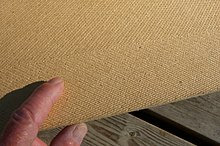This article has multiple issues. Please help improve it or discuss these issues on the talk page. (Learn how and when to remove these messages)
|




Masonite, also called Quartboard or pressboard, is a type of engineered wood made of steam-cooked and pressure-molded wood or paper fibers. The fibers form a stiff, dense material in a range of weights.
The process was formulated and patented by William H. Mason.
Masonite has been widely used in traditional school and office products such as spiral-bound notebooks and three-ring binders, but its unique physical characteristics lend itself readily to a variety of end-uses, including (but not limited to) document storage, filing supplies (classification and file folders), report covers, folding cartons, tags, labels, and industrial applications.
History
In 1898, a product resembling Masonite (hardboard) was first made in England by hot-pressing waste paper.
In 1924, Masonite was patented in Laurel, Mississippi, by William H. Mason, who was a friend and protégé of Thomas Edison.
In 1929, the company initiated mass production of its product.
In the 1930s and 1940s, Masonite was used for applications including doors, roofing, walls, desktops, guitars (e.g., Danelectro), and canoes. It was sometimes used for house siding. Similar "tempered hardboard" is now a generic product made by many forest product companies.
In 1972, the Masonite Corporation entered the door business as a supplier of facings.
In 2001, the Masonite Corporation was purchased by Premdor Corporation, a door maker, from its former parent International Paper. It no longer supplies generic hardboard.
Production
Masonite is formed using the Mason method, in which wood chips are disintegrated by saturating them with 100-pound-per-square-inch (690 kPa) steam, then increasing the steam or air pressure to 400 pounds per square inch (2,800 kPa) and suddenly releasing them through an orifice to atmospheric pressure. Forming the fibers into boards on a screen, the boards are then pressed and heated to form the finished product with a smooth burnished finish. (Later a dry process with two burnished surfaces was also used.) The original lignin in the wood serves to bond the fibers without any added adhesive. The long fibers give Masonite a high bending strength, tensile strength, density, and stability. Unlike other composite wood panels, no formaldehyde-based resins are used to bind the fibers in Masonite.
Materials
Masonite may contain recycled fiber content (including post-consumer waste), and is typically itself recyclable and biodegradable, making it an environmentally-sound choice for those seeking an alternative to petroleum-derived substrates.
Masonite has also been made from cornstalks.
Use

Artists have often used it as a support for painting, and in artistic media such as linocut printing. Masonite's smooth surface makes it a suitable material for table tennis tables and skateboard ramps.
Masonite is used by moving companies. Among other things, they use it to protect the walls of buildings where they work, and lay on floors to enable smooth rolling of dollies loaded with goods.
Deterioration
Masonite swells and rots over time when exposed to the elements, and may prematurely deteriorate when it is used as exterior siding. In 1996, International Paper (IP) lost a class action suit brought by homeowners whose Masonite siding had deteriorated. The jury found that IP's Masonite siding was defective.
See also
- Fiberboard – Engineered wood product made out of wood fibers
- Oriented strand board – Engineered wood particle board
- Paintings on masonite – Series of paintings by Joan MiróPages displaying short descriptions of redirect targets
- Particle board – Glued wood product
- Plywood – Manufactured wood panel made from thin sheets of wood veneer
References
- Quartrboard. First Use Anywhere Date: 1927-05-13
- Masonite: insulation, presdwood, quartboard, lath, tempered presdwood, tempritile, cushioned flooring. (1935)
- "What is Pressboard and Pressed Wood? | Definition of Pressboard and Pressed Wood". Kitchen Cabinet Kings. Retrieved August 1, 2021.
- "The History of Masonite". Archived from the original on October 20, 2011. Retrieved September 2, 2011.
- Bhel (January 1, 2003). Transformers. Tata McGraw-Hill Education. ISBN 978-0-07-048315-6.
- Staff, British Standards Institute (February 15, 1998). Insulating Liquids. Oil-Impregnated Paper and Pressboard. Determination of Water by Automatic Coulometric Karl Fischer Titration. B S I Standards. ISBN 978-0-580-29356-6.
- Harlow, James H. (May 16, 2012). Electric Power Transformer Engineering, Third Edition. CRC Press. ISBN 978-1-4398-5629-1.
- Akers, 1966, p. x
- "1925 - Masonite Europe". Masonite Europe. Archived from the original on August 5, 2009. Retrieved September 23, 2009.
- SouthBear (March 23, 2002). "William H. Mason: The Man Who Went to Lunch". Archived from the original on April 13, 2012. Retrieved February 24, 2012.
- "The History of Masonite". Archived from the original on October 20, 2011. Retrieved September 2, 2011.
- U.S. Patents 1,578,609 and 1,586,159.
- Wingfield, Baker; Naffziger, T. R.; Whittemore, Edward Richard; Overman, Charles Beatty; Sweeney, Orland Russell; Acree, Solomon Farley (1936). Production of Pressboard from Cornstalks. U.S. Government Printing Office.
- "Joan Miró: Painting and Anti-Painting 1927-1937". Online exhibition catalogue. MoMA. Retrieved April 25, 2012.
- Christie's, Louis Valtat, "Child on the Carpet", 1910
- "How Movers Prepare and Protect a Home". moversville.com. Retrieved June 24, 2016.
- "Jury finds International Paper's Masonite siding defective". Thefreelibrary.com. September 13, 1996. Retrieved September 23, 2009.
External links
| Wood products | |
|---|---|
| Lumber/ timber | |
| Engineered wood | |
| Fuelwood | |
| Fibers | |
| Derivatives | |
| By-products | |
| Historical | |
| See also | |
Categories: